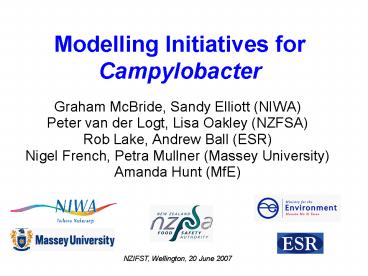Modelling Initiatives for Campylobacter - PowerPoint PPT Presentation
1 / 13
Title:
Modelling Initiatives for Campylobacter
Description:
Focus to date has been on human exposure, less on sources and transmission (but there is some) ... Incorporate data on red meat, pets, overseas travel ... – PowerPoint PPT presentation
Number of Views:41
Avg rating:3.0/5.0
Title: Modelling Initiatives for Campylobacter
1
Modelling Initiatives for Campylobacter
- Graham McBride, Sandy Elliott (NIWA)
- Peter van der Logt, Lisa Oakley (NZFSA)
- Rob Lake, Andrew Ball (ESR)
- Nigel French, Petra Mullner (Massey University)
- Amanda Hunt (MfE)
NZIFST, Wellington, 20 June 2007
2
Motivation
- NZs high reported rate of campylobacteriosis
(cost 70m p.a.) - Focus to date has been on human exposure, less on
sources and transmission (but there is some) - Campylobacter is a zoonotic pathogen animals
are the main reservoir - Time to marry environmental models with food and
health models, in a quantitative risk framework - Try to identify effective mitigation measures
- NZFSA/MfE (supported by MoH) gained CDRP funding
for modelling
3
Conceptual model
Food safety
Animal systems
4
Preliminary relative risk model (1)
5
Preliminary relative risk model (2)
6
Preliminary landscape mitigation model
7
Three-Year Research Plan
- Three components
- Improve existing human exposure models
- Extend existing ecological/environmental models
- Establish the links between the models
- www.zoonosesresearch.org.nz/research-priorities/
three-year-research-plan-10_8.pdf - www.zoonosesresearch.org.nz/reports/PreliRelativ
eriskAssessment.pdf
8
(1) Improve existing human exposure models
- Refine occupational contact
- Incorporate data on red meat, pets, overseas
travel - Incorporate Campylobacter strain typing data
- Build in between-group differential immunity
- Better identification of exposures via food
handling channels
9
(2) Extend existing ecological environmental
models
- Include sheep and poultry farms (cf. dairy only)
- Account for animal litter disposal
- Incorporate more detailed catchment dynamics
- Incorporate disturbance effects (e.g., floods)
- Include pathogen carriage and transmission
between animals - Incorporate data on sewage and biosolids disposal
10
(3) Establish the links between the models
- Develop generic framework
- Progressively update framework details
- Liaise with risk managers
- mitigation options and deliverables
- Model effects of mitigation options
- Detailed risk modelling
11
Strategy
- Governance/oversight group to be set up
- Use a variety of modelling techniques
- Monte Carlo, Bayesian, mechanistic, statistical,
analytical solutions (linear models) - Team meets 3-4 times per year
- Ongoing liaison with risk managers
- Status paper in prep. for NZ Science Review
- Many parallel tasks
12
Benefits of modelling
- Draws on a wide range of published results, and
unpublished in-progress work - Opportunity to be innovative
- Maximum use of accumulating typing data
- Integrativelinking environment health models
- International importance
- Framework will be applicable to other zoonotic
pathogens transmitted via multiple food and
environmental pathways
13
Conclusions
- Challenging task
- Integrative approach offers best prospect of
success, especially when married to faecal
source-tracking techniques - Some mitigation measures may not be obvious
(e.g., animal inoculation?)































